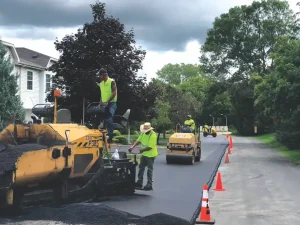Asphalt, the most popular and preferred option for pavement projects, is durable. However, it has a natural life cycle, and at some point, it will fail. Pavement failures can arise from several factors, including excessive stress, moisture intrusion, sun exposure, and contraction and expansion from seasonal changes. Pavement failure issues come in many forms and can happen for months or years, but they can also be sudden. This article will cover the common types of pavement failures, their causes, prevention, and mitigation strategies.
Pavement Failures
Pavement failure occurs when an asphalt surface loses its structural integrity and no longer holds its original shape. When this happens, the pavement loses its aesthetic value and becomes dangerous for users. Pavement with cracks, potholes, depressions, rutting, upheavals, shoving, or raveling can cause real danger and attract serious liabilities. The common causes of pavement failures include:
Cracking
Asphalt cracking is the leading cause of pavement failures because it tends to grow and spread. It’s normal for asphalt to develop cracks over time due to soil settling and exposure to various elements. However, some cracks can result from improper mix design and pavement installation. Asphalt cracking occurs in a variety of ways, including:
- Alligator cracking: a pattern of interlaced cracks resembling the scales on the back of an alligator’s skin. Causes include base, surface, and subgrade weaknesses, improper drainage design, excessive vehicular load, and poor design and installation.
- Edge cracking: forms along the edge of the pavement and is typically caused by heavy usage, water damage, and insufficient base material.
- Block cracking: a box-like pattern of cracks that form on the asphalt surface that form due to unequal expansion and contraction caused by seasonal temperature changes.
- Linear cracking: a type of cracking that runs parallel to the roadway and is caused mainly by pavement fatigue.
Potholes
Potholes are another common cause of asphalt damage that often arises from moisture seeping through the cracks into the pavement’s surface. If cracks are left untreated for a long time, water starts eroding the surface and penetrating deep into the subbase, causing holes to form. Besides untreated cracks, potholes can be caused by general pavement fatigue.
You can prevent potholes by ensuring proper pavement design and asphalt installation. However, if the damage is already done and potholes have already formed, you can perform repairs through asphalt patchwork.
Depression
A depressed asphalt surface is usually uneven and characterized by slightly lower elevations than the asphalt surface. Depressions can be attributed to unequal compaction, uneven sub-base, and foundation soil settlement. They may not be noticeable until it rains; that’s when they hold water. The water buildup can cause further damage like potholes or raveling over time.
Depressions on the asphalt surface often arise from the pavement losing its structural integrity. So, the best way to prevent this type of damage is to ensure proper asphalt installation and prevent heavy traffic. However, once depressions have occurred, you can fix the problem by either patching minor depressions or replacing the entire asphalt surface for severe depression.
Raveling
Raveling is a type of pavement failure caused by continued water intrusion and degradation of the topmost asphalt layer. As the topcoat of the asphalt degrades and water intrudes, causing ravels, and when this happens, your pavement can no longer block water from entering the asphalt, resulting in more cracks and failure. Sealing the affected area can go a long way in fixing the problem.
Bottom Line
Proper maintenance and regular repairs can go a long way in keeping pavement in great condition for years to come. Unfortunately, because some of the pavement failure issues are unexpected, they often result in unplanned expenses, forcing many property owners to result to quick fixes. Surface solutions are great, but when there is an underlying structural problem, these solutions will be short-lived. So, instead of wasting time and money on a quick fix, it pays to work with a professional pavement repair provider such as Pro-Pave Inc.
At Pro-Pave Inc., we offer free on-site consultations where we inspect the pavement and come up with an action plan for effective results. Contact us today for more information.





